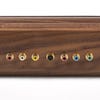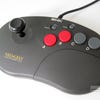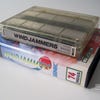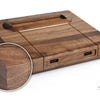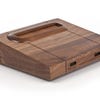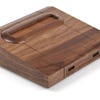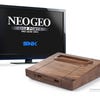Wooden SNK Neo Geo CMVS
You know you wood.
There once was a time when varnished wood was considered to symbolise the very height of affluence and sophistication. Cladding your product - be it a motor vehicle, wireless radio or television set - with timber panelling was widely regarded as a sound idea if you wanted to attract the attention of fashion-conscious consumers back in the 1970s, but then so were glitter-encrusted platform boots, bedside coffee machines and The Bee Gees.
Mercifully, mankind's obsession for faux wood-effect consumer goods died out with the dawn of the plastic-obsessed eighties, but that doesn't mean that electrical items crafted from trees have entirely lost their lustre - as the unique wooden SNK Neo Geo MVS capably proves.
Produced by Analogue Interactive in the United States, this striking piece of hardware is the video game equivalent of a prohibitively expensive hi-fi separate or a custom-made suit. Fashioned with the hardcore enthusiast in mind and sure to become the stuff of legend in collectors' circles, it doesn't really get any better than this for rampant SNK fanboys.
MVS vs. AES
But there's a good chance that this machine may be of interest to those who aren't card-carrying Neo Geo freaks, so before we delve a little deeper into this 100 per cent walnut-encased console oddity, it's worth recapping exactly what kind of beast we're dealing with here. SNK's Neo Geo system premiered in 1990 and has gone on to become a cult; famous to many, yet played and owned by comparatively few.
Its genesis was down to SNK's desire to offer long-suffering arcade operators a risk-free route to profitability. Unlike most arcade machines of the era - which either came in expensive dedicated cabinets (see Sega's Space Harrier and After Burner) or used unwieldy and easily-damaged PCB boards - the Neo Geo MVS (Multi Video System) took inspiration from the burgeoning home console scene and utilised universal cabinets and easily-swappable compact cartridges.
The benefits were obvious; once a game had reached the end of its lifespan, the operator could simply whip it out of the robust MVS cabinet and replace it with a newer, fresher release.
Not content with succeeding in the coin-op arena, SNK also launched the AES (Advanced Entertainment System), which was essentially the MVS hardware repackaged for domestic use. The price tag of the hardware was astronomical, and the games themselves retailed for over £200 apiece - a truly eye-watering sum, even by today's standards. After all, this was cutting edge coin-op technology, and it made rival platforms like the Mega Drive and SNES look weedy in comparison.
Regardless of their format - AES or MVS - Neo Geo games were identical. Every cart used the same chips across both standards, the only difference being that when played on an MVS, games would default to the arcade setting (which required coins to be inserted to play) while on the AES a 'free-play' approach was selected. However, in order to prevent industrious arcade owners from purchasing the (then) cheaper home cartridges and making a tidy profit with their MVS cabinets, SNK ensured that the software from one system could not physically be played on the other.

Ironically, as the years have rolled by, the AES editions have become much more valuable than their MVS counterparts due to lower production runs and more attractive packaging. For example, a copy of Metal Slug on MVS will cost you no more than £50, while the ultra-rare AES edition is known to fetch well over £1000 on the second-hand market.
For this reason, many retro gamers opt for the MVS system rather than an AES one, as the software is usually much more affordable. Hence the coining of the term 'Consolised MVS'. Broadly speaking, this process involves ripping out the guts of the MVS hardware from its arcade cabinet and tinkering so that it functions on a standard television set.



